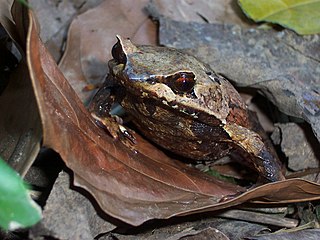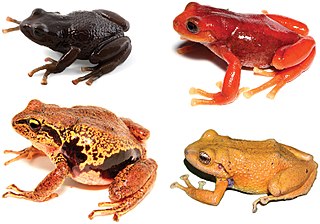
Megophryidae, commonly known as goose frogs, is a large family of frogs native to the warm southeast of Asia, from the Himalayan foothills eastwards, south to Indonesia and the Greater Sunda Islands in Maritime Southeast Asia, and extending to the Philippines. Fossil remains are also known from North America. As of 2014 it encompasses 246 species of frogs divided between five genera. For lack of a better vernacular name, they are commonly called megophryids.
Atympanophrys is a genus of frogs in the family Megophryidae. They range from central China south to northern Vietnam. They are commonly known as hidden-tympanum horned toads.

Limnonectes is a genus of fork-tongued frogs of about 75 known species, but new ones are still being described occasionally. They are collectively known as fanged frogs because they tend to have unusually large teeth, which are small or absent in other frogs.

Meristogenys is a genus of true frogs from Borneo. Its tadpoles are adapted to fast-flowing mountain streams and easily recognizable by their divided upper lip with ribs on the outside.

Microhyla, commonly known as the rice frogs or narrow-mouthed frogs, is a genus of frogs in the family Microhylidae. It consists of 42 species of diminutive frogs. Members of this genus are widespread from Ryukyu Is. in Japan, and throughout South-east Asia,.

Megophrys is a genus of frogs in the family Megophryidae. They are endemic to Indonesia, where they are found on the islands of Java and Sumatra. They commonly have elongated upper "eyebrows" and are thus known as Indonesian horned toads. This group was thought to contain many more species and have a much wider distribution prior to recent taxonomic revisions.

Megophrys montana is a species of frog found in Java and possibly Sumatra.
Megophrys parallela is a species of frog in the family Megophryidae. It is endemic to Sumatra and known from a number of localities on mountains along the island's western coast where it is expected to have a wide distribution.
The Kuatun horned toad, or Kuatun spadefoot toad, is a species of frog in the family Megophryidae. It is found in southeastern China and northern Vietnam. Its name is testimony to its type locality, Kuatun village in Wuyishan, Fujian.
Limnonectes shompenorum is a species of frog in the family Dicroglossidae. It is found in Great Nicobar Island (India), its type locality, and in western Sumatra (Indonesia). It is similar to Limnonectes macrodon. The name refers to Shompen people, the indigenous people of the interior of Great Nicobar Island.
Meristogenys amoropalamus is a species of frog in the family Ranidae. It is endemic to northern Borneo and occurs in northwestern Sabah and northeastern Sarawak (Malaysia) and in northeastern Kalimantan (Indonesia). Common names mountain Borneo frog and mountain torrent frog have been coined for it. Studies of its larvae revealed that the nominal species contained two cryptic forms, and in 2011, Shimada and colleagues described Meristogenys dyscritus as a separate species.
Rhacophorus poecilonotus, also known as the Sumatra flying frog, is a species of frog in the family Rhacophoridae. It is endemic to Sumatra, Indonesia.
Djoko Tjahjono Iskandar is an Indonesian herpetologist who studies the amphibians of Southeast Asia and Australasia. He is a professor of biosystematics and ecology at Bandung Institute of Technology in West Java, Indonesia.

Craugastoridae, commonly known as fleshbelly frogs, is a family of New World direct-developing frogs. As delineated here, following the Amphibian Species of the World, it contains 129 species. They are found from the southern United States southwards to Central and South America.
Boulenophrys sangzhiensis is a species of frog in the family Megophryidae. It is endemic to China, being only known from the type locality in Sangzhi County, Hunan, in south-central China.
Xenophrys damrei is a species of megophryid toad endemic to Cambodia. It is only known from its type locality, Bokor Plateau in the Dâmrei Mountains of southern Cambodia. The species description was published in 2011 but was based on samples collected by Malcolm Arthur Smith in 1914. The species has not been observed in surveys ever since, although this might reflect seasonal variability. The known specimens measure 69 mm (2.7 in) and 57 mm (2.2 in) in snout–vent length.

Pelobatrachus is a genus of frogs in the family Megophryidae. It was formerly synonymized with Megophrys until 2021, when it was revived as a distinct genus. They inhabit Southeast Asia, namely the Malay Peninsula, Sumatra, Borneo and the Philippines. Their common name is clay horned toads.
Megophrys acehensis, the Aceh horned frog, is a species of frog from the genus Megophrys. The species is endemic to Indonesia and was scientifically described in 2021.
Pelobatrachus kalimantanensis, the Kalimantan horned frog, is a species of frog from the Pelobatrachus genus. It is native to forests and wetlands of Indonesia. The species was scientifically described in 2019.
Megophrys selatanensis, the South-Sumatran horned-frog, is a species of frog from the genus Megophrys to Indonesia. The species was scientifically described in 2021.







